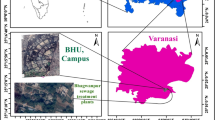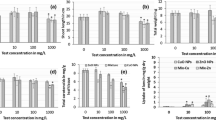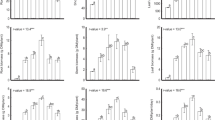Abstract
Considering its richness in organic and inorganic mineral nutrients, the recycling of sewage sludge (SS) is highly considered as a soil supplement in agriculture. However, the fate of hazardous heavy metal accumulation in the crops cultivated in SS amended soils is always a source of concern. Since nanoparticles are widely recognized to reduce heavy metal uptake by crop plants; thus, the present experiment deals with okra (Abelmoschus esculentus L. Moench) cultivation under the combined application of SS and TiO2-nanoparticles (NPs). Triplicated pot experiments were conducted using different doses of SS and TiO2-NPs such as 0 g/kg SS (control), 50 g/kg SS, 50 g/kg SS + TiO2, 100 g/kg SS, and 100 g/kg SS + TiO2, respectively. The findings of this study indicated that among the doses of treatment combinations investigated, 100 g/kg SS + TiO2 showed a significant (p < 0.05) increase in the okra plant yield (287.87 ± 4.06 g/plant) and other biochemical parameters such as fruit length (13.97 ± 0.54 cm), plant height (75.05 ± 3.18 cm), superoxide dismutase (SOD: 110.68 ± 3.11 μ/mg), catalase (CAT: 81.32 ± 3.52 μ/mg), and chlorophyll content (3.12 ± 0.05 mg/g fwt.). Also, the maximum contents of six heavy metals in the soil and cultivated okra plant tissues (fruit, stem, and root regions) followed the order of Fe > Mn > Cu > Zn > Cr > Cd using the same treatment. Bioaccumulation and health risk assessment indicated that foliar application of TiO2-NPs significantly reduced the fate of heavy metal accumulation under higher doses of SS application. Therefore, the findings of this study suggested that the combined use of SS and TiO2-NPs may be useful in ameliorating the negative consequences of heavy metal accumulation in cultivated okra crops.





Similar content being viewed by others
Data availability
Not applicable.
Change history
15 October 2022
A Correction to this paper has been published: https://doi.org/10.1007/s11356-022-23655-9
References
Adelodun B, Ajibade FO, Ighalo JO, Odey G, Ibrahim RG, Kareem KY, Bakare HO, Tiamiyu AO, Ajibade TF, Abdulkadir TS, Adeniran KA, Choi KS (2021) Assessment of socioeconomic inequality based on virus-contaminated water usage in developing countries: a review. Environ Res 192:110309. https://doi.org/10.1016/j.envres.2020.110309
Ali M, Niaz Y, Abbasi GH, Ahmad S, Malik Z, Kamran M, Ayaz M (2021) Exogenous zinc induced NaCl tolerance in okra (Abelmoschus esculentus) by ameliorating osmotic stress and oxidative metabolism. Commun Soil Sci Plant Anal 52(7):743–755. https://doi.org/10.1080/00103624.2020.1869761
Ametepey ST, Cobbina SJ, Akpabey FJ, Duwiejuah AB, Abuntori ZN (2018) Health risk assessment and heavy metal contamination levels in vegetables from Tamale Metropolis, Ghana. Int J Food Contam 5:1–8. https://doi.org/10.1186/s40550-018-0067-0
AOAC (2005) In: Official methods of analysis of the association of official analytical chemists. 13th edition, pp. 545–567
AOAC (2019) Official Methods of Analysis, 21st Edition (2019) - AOAC International. https://www.aoac.org/official-methods-ofanalysis-21st-edition-2019/. Accessed 10 Sep 2021
APHA, AWWA, WEF (2012) Standard methods for the examination of water and wastewater, 21st Edition. American Public Health Association, Washington, pp. 2462. https://www.standardmethods. org/
Chaudhary IJ, Singh V (2020) Titanium dioxide nanoparticles and its impact on growth, biomass and yield of agricultural crops under environmental stress: a review. Res J Nanosci Nanotechnol 10(1):1–8. https://doi.org/10.3923/rjnn.2020.1.8
Chen X, Selloni A (2014) Introduction: titanium dioxide (TiO2) nanomaterials. Chem Rev 114(19):9281–9282. https://doi.org/10.1021/cr500422r
Cieślik BM, Namieśnik J, Konieczka P (2015) Review of sewage sludge management: standards, regulations and analytical methods. J Clean Prod 90:1–15. https://doi.org/10.1016/j.jclepro.2014.11.031
da Silva WR, do Nascimento CWA, da Silva FBV, de Souza AAB, Fracetto GGM, Ximenes DHDSV (2021) Effects of sewage sludge stabilization processes on soil fertility, mineral composition, and grain yield of maize in successive cropping. J Soil Sci Plant Nutr 21(2):1076–1088. https://doi.org/10.1007/s42729-021-00423-1
Eid E, Alrumman SA, El-Bebany AF, Fawy KF, Taher MA, Hesham AEL, Ahmed MT (2019) Evaluation of the potential of sewage sludge as a valuable fertilizer for wheat (Triticum aestivum L.) crops. Environ Sci Pollut Res 26(1):392–401. https://doi.org/10.1007/s11356-018-3617-3
Eid E, Alrumman SA, El-Bebany AF, Fawy KF, Taher MA, Hesham AEL, Ahmed MT (2018) The evaluation of sewage sludge application as a fertilizer for broad bean (Faba sativa Bernh.) crops. Food Energy Secur 7(3):e00142. https://doi.org/10.1002/fes3.142
Eid EM, Kumar P, Adelodun B, Choi KS, Singh J, Kumari S, Kumar V (2021a) Modeling of mineral elements uptake and localization in cabbage inflorescence (Brassica oleracea var. capitata) grown on sugar mill pressmud-amended soils. Environ Monit Assess 193(9):1–13. https://doi.org/10.1007/s10661-021-09381-8
Eid EM, Shaltout KH, Alamri SAM (2021b) Monitored sewage sludge application improves soil quality, enhances plant growth, and provides evidence for metal remediation by Sorghum bicolor L. J Soil Sci Plant Nutr 21:2325–2338. https://doi.org/10.1007/s42729-021-00524-x
EUROSTAT (2014) Environment data base. http://epp.eurostat.ec.europa.eu/portal/page/portal/environment/data/database. Accessed 07 December 2021
Goala M, Yadav KK, Alam J, Adelodun B, Choi KS, Cabral-Pinto MMS, Hamid AA, Alhoshan M, Ali FAA, Shukla AK (2021) Phytoremediation of dairy wastewater using Azolla pinnata: application of image processing technique for leaflet growth simulation. J Water Process Eng 42:102152. https://doi.org/10.1016/j.jwpe.2021.102152
Hong J, Wang C, Wagner DC, Gardea-Torresdey JL, He F, Rico CM (2021) Foliar application of nanoparticles: mechanisms of absorption, transfer, and multiple impacts. Environ Sci Nano 8(5):1196–1210. https://doi.org/10.1039/D0EN01129K
Hu J, Wu X, Wu F, Chen W, White JC, Yang Y, Wang X (2020) Potential application of titanium dioxide nanoparticles to improve the nutritional quality of coriander (Coriandrum sativum L.). J Hazard Mater 389:121837. https://doi.org/10.1016/j.jhazmat.2019.121837
Hube S, Wu B (2021) Mitigation of emerging pollutants and pathogens in decentralized wastewater treatment processes: a review. Sci Total Environ 779:146545. https://doi.org/10.1016/j.scitotenv.2021.146545
Irshad MA, Ur Rehman MZ, Anwar-ul-Haq M, Rizwan M, Nawaz R, Shakoor MB, Ali S (2021) Effect of green and chemically synthesized titanium dioxide nanoparticles on cadmium accumulation in wheat grains and potential dietary health risk: a field investigation. J Hazard Mater 415:125585. https://doi.org/10.1016/j.jhazmat.2021.125585
Jampílek J, Kráľová K (2015) Application of nanotechnology in agriculture and food industry, its prospects and risks. Ecol Chem Eng S 22(3):321–361. https://doi.org/10.1515/eces-2015-0018
Kolenčík M, Ernst D, Urík M, Ďurišová Ľ, Bujdoš M, Šebesta M, Kratošová G (2020) Foliar application of low concentrations of titanium dioxide and zinc oxide nanoparticles to the common sunflower under field conditions. Nanomater 10(8):1619. https://doi.org/10.3390/nano10081619
Kumar V, Kumar P, Khan A (2020a) Optimization of PGPR and silicon fertilization using response surface methodology for enhanced growth, yield and biochemical parameters of French bean (Phaseolus vulgaris L.) under saline stress. Biocatal Agric Biotechnol 23:101463. https://doi.org/10.1016/j.bcab.2019.101463
Kumar V, Kumar P, Singh J, Kumar P (2020b) Potential of water fern (Azolla pinnata R. Br.) in phytoremediation of integrated industrial effluent of SIIDCUL, Haridwar, India: removal of physicochemical and heavy metal pollutants. Int J Phytoremediation 22(4):392–403. https://doi.org/10.1080/15226514.2019.1667950
Kumar V, Kumar P, Singh J, Kumar P (2021) Use of sugar mill wastewater for Agaricus bisporus cultivation: prediction models for trace metal uptake and health risk assessment. Environ Sci Pollut Res 28(21):26923–26934. https://doi.org/10.1007/s11356-021-12488-7
Kumar V, Eid EM, Al-Bakre DA, Abdallah SM, Širić I, Andabaka Ž, Kumar P, Goala M, Adelodun B, Singh J, Kumari S, Bachheti A, Arya AK, Choi K-S (2022) Combined Use of Sewage Sludge and Plant Growth-Promoting Rhizobia Improves Germination, Biochemical Response and Yield of Ridge Gourd (Luffa acutangula (L.) Roxb.) under Field Conditions. Agric 12(2):173. https://doi.org/10.3390/agriculture12020173
Li S, Zhang K, Zhou S, Zhang L, Chen Q (2009) Use of dewatered municipal sludge on Canna growth in pot experiments with a barren clay soil. Waste Manag 29(6):1870–1876. https://doi.org/10.1016/j.wasman.2008.12.007
Lin X, Li S, Wei Z, Chen Y, Hei L, Wu QT (2021) Indirect application of sludge for recycling in agriculture to minimize heavy metal contamination of soil. Resour Conserv Recy 166:105358. https://doi.org/10.1016/j.resconrec.2020.105358
Malik OA, Hsu A, Johnson LA, de Sherbinin A (2015) A global indicator of wastewater treatment to inform the sustainable development goals (SDGs). Environ Sci Policy 48:172–185. https://doi.org/10.1016/j.envsci.2015.01.005
Mara D (2013) Domestic wastewater treatment in developing countries. Earthscan Publications, Routledge, p 311
Mittal D, Kaur G, Singh P, Yadav K, Ali SA (2020) Nanoparticle-based sustainable agriculture and food science: recent advances and future outlook. Front Nanotechnol 2:10. https://doi.org/10.3389/fnano.2020.579954
Ogunkunle CO, Odulaja DA, Akande FO, Varun M, Vishwakarma V, Fatoba PO (2020) Cadmium toxicity in cowpea plant: effect of foliar intervention of nano-TiO2 on tissue Cd bioaccumulation, stress enzymes and potential dietary health risk. J Biotechnol 310:54–61. https://doi.org/10.1016/j.jbiotec.2020.01.009
Pachura P, Ociepa-Kubicka A, Skowron-Grabowska B (2016) Assessment of the availability of heavy metals to plants based on the translocation index and the bioaccumulation factor. Desalin Water Treat 57(3):1469–1477. https://doi.org/10.1080/19443994.2015.1017330
Panpatte DG, Jhala YK, Shelat HN, Vyas RV (2016) Nanoparticles: the next generation technology for sustainable agriculture. Microbial inoculants in sustainable agricultural productivity. Springer, New Delhi, pp 289–300
Pestovsky YS, Martínez-Antonio A (2017) The use of nanoparticles and nanoformulations in agriculture. J Nanosci Nanotechnol 17(12):8699–8730. https://doi.org/10.1166/jnn.2017.15041
Qian L, Wang S, Xu D, Guo Y, Tang X, Wang L (2016) Treatment of municipal sewage sludge in supercritical water: a review. Water Res 89:118–131. https://doi.org/10.1016/j.watres.2015.11.047
Rico CM, Majumdar S, Duarte-Gardea M, Peralta-Videa JR, Gardea-Torresdey JL (2011) Interaction of nanoparticles with edible plants and their possible implications in the food chain. J Agric Food Chem 59(8):3485–3498. https://doi.org/10.1021/jf104517j
Rizwan M, Ali S, Ur Rehman MZ, Malik S, Adrees M, Qayyum MF, Ahmad P (2019) Effect of foliar applications of silicon and titanium dioxide nanoparticles on growth, oxidative stress, and cadmium accumulation by rice (Oryza sativa). Acta Physiol Plant 41(3):1–12. https://doi.org/10.1007/s11738-019-2828-7
Rodrigues Prates A, Renée Coscione A, Carvalho Minhoto Teixeira Filho M, Gasparoti Miranda B, Arf O, Hamilton Abreu-Junior C, Assis Rodrigues Nogueira T (2020) Composted sewage sludge enhances soybean production and agronomic performance in naturally infertile soils (Cerrado Region, Brazil). Agronomy 10(11):1677. https://doi.org/10.3390/agronomy10111677
Sabeen AH, Noor ZZ, Ngadi N, Almuraisy S, Raheem AB (2018) Quantification of environmental impacts of domestic wastewater treatment using life cycle assessment: a review. J Clean Prod 190:221–233. https://doi.org/10.1016/j.jclepro.2018.04.053
Sato T, Qadir M, Yamamoto S, Endo T, Zahoor A (2013) Global, regional, and country level need for data on wastewater generation, treatment, and use. Agric Water Manag 130:1–13. https://doi.org/10.1016/j.agwat.2013.08.007
Shahid M, Farooq ABU, Rabbani F, Khalid S, Dumat C (2020) Risk assessment and biophysiochemical responses of spinach to foliar application of lead oxide nanoparticles: a multivariate analysis. Chemosphere 245:125605. https://doi.org/10.1016/j.chemosphere.2019.125605
Shaltout KH, Alamri SA, Alrumman SA, Hussain AA, Sewelam N, Eid EM (2021) Evaluation of uptake of eight metals by Sorghum bicolor grown in arable soil combined with sewage sludge based on prediction models. Environ Monit Asses 193(8):1–15. https://doi.org/10.1007/s10661-021-09320-7
Tagg AS, Brandes E, Fischer F, Fischer D, Brandt J, Labren M (2021) Agricultural application of microplastic-rich sewage sludge leads to further uncontrolled contamination. Sci Total Environ 150611:1–10. https://doi.org/10.1016/j.scitotenv.2021.150611
Tytła M (2019) Assessment of heavy metal pollution and potential ecological risk in sewage sludge from municipal wastewater treatment plant located in the most industrialized region in Poland-case study. Int J Environ Res Public Health 16(13):2430. https://doi.org/10.3390/ijerph16132430
Ullah S, Adeel M, Zain M, Rizwan M, Irshad MK, Jilani G, Rui Y (2020) Physiological and biochemical response of wheat (Triticum aestivum) to TiO2 nanoparticles in phosphorous amended soil: A full life cycle study. J Environ Manag 263:110365. https://doi.org/10.1016/j.jenvman.2020.110365
UNWWR (2021) United Nations World Water Report. Progress on Wastewater Treatment - 2021 Update. IMI-SDG6 SDG 6 PROGRESS REPORTS. Available online at: https://www.unwater.org/publications/progress-on-wastewater-treatment-631-2021-update/
USEPA (2011) Integrated Risk Information System, USEPA. https://www.epa.gov/iris. Accessed 18 November 2021
Walkley A, Black IA (1934) An examination of the Degtjareff method for determining soil organic matter and a proposed modification of the chromic acid titration method. Soil Sci 37:29–38
Yakamercan E, Ari A, Aygün A (2021) Land application of municipal sewage sludge: human health risk assessment of heavy metals. J Clean Prod 319:128568. https://doi.org/10.1016/j.jclepro.2021.128568
Zhou P, Adeel M, Shakoor N, Guo M, Hao Y, Azeem I, Rui Y (2021) Application of nanoparticles alleviates heavy metals stress and promotes plant growth: an overview. Nanomater 11(1):26. https://doi.org/10.3390/nano11010026
Zuo W, Bai Y, Lv M, Tang Z, Ding C, Gu C, Li M (2021) Sustained effects of one-time sewage sludge addition on rice yield and heavy metals accumulation in salt-affected mudflat soil. Environ Sci Pollut Res 28(6):7476–7490. https://doi.org/10.1007/s11356-020-11115-1
Acknowledgements
This research work is a person-to-person collaboration between Dr. Pankaj Kumar and Prof. Ebrahem M. Eid. The authors are grateful to their host institutes for providing necessary experimental facilities.
Funding
The authors extend their appreciation to the Deputyship for Research and Innovation, Ministry of Education, in Saudi Arabia for funding this research work through the project number IFP-KKU-2020/3.
Author information
Authors and Affiliations
Contributions
Pankaj Kumar: conceptualization, methodology, investigation, writing: original draft preparation, data curation, software, validation; Saad A.M. Alamri: writing: writing: review and editing, validation; Sulaiman A. Alrumman: writing: review and editing, validation; Ebrahem M. Eid: methodology, supervision, project administration, review and editing, validation; Bashir Adelodun: software, writing: review and editing, validation; Madhumita Goala: software, writing: review and editing, validation; Kyung Sook-Choi: writing: review and editing, validation; Vinod Kumar: methodology, supervision, review and editing, resources, validation.
Corresponding author
Ethics declarations
Ethics approval
This article does not contain any studies with human participants or animals.
Consent to participate
All the authors mutually agreed to participate in this work.
Consent for publication
All the authors mutually agreed to publish the work.
Competing interests
The authors declare no competing interests.
Additional information
Responsible Editor: Gangrong Shi
Publisher's note
Springer Nature remains neutral with regard to jurisdictional claims in published maps and institutional affiliations.
Rights and permissions
Springer Nature or its licensor (e.g. a society or other partner) holds exclusive rights to this article under a publishing agreement with the author(s) or other rightsholder(s); author self-archiving of the accepted manuscript version of this article is solely governed by the terms of such publishing agreement and applicable law.
About this article
Cite this article
Kumar, P., Alamri, S.A.M., Alrumman, S.A. et al. Foliar use of TiO2-nanoparticles for okra (Abelmoschus esculentus L. Moench) cultivation on sewage sludge–amended soils: biochemical response and heavy metal accumulation. Environ Sci Pollut Res 29, 66507–66518 (2022). https://doi.org/10.1007/s11356-022-20526-1
Received:
Accepted:
Published:
Issue Date:
DOI: https://doi.org/10.1007/s11356-022-20526-1




